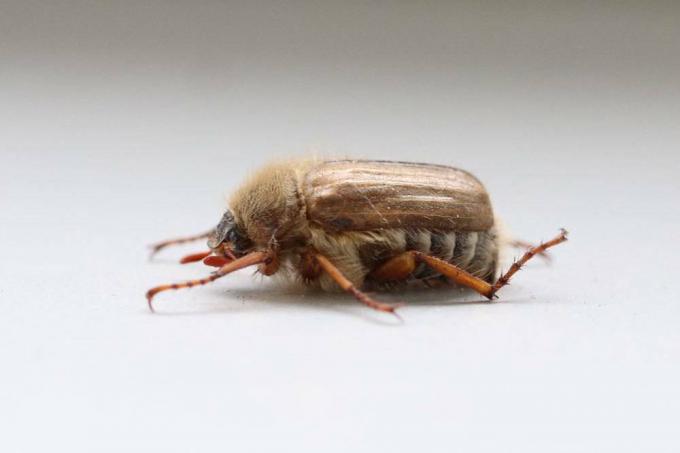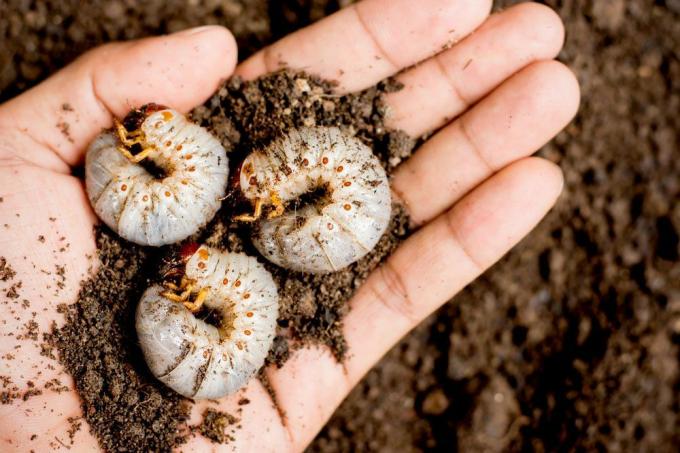
table of contents
- White grubs in the lawn
- Recognize harmful species
- Larvae
- Beetle
- Preventing grubs
- Fight grubs
- Collecting instead of killing
- Animals as useful helpers
- Fight with plants
- Falling
- Housing offer
- Nematodes
Larvae of beetles are called grubs. The thick, white larvae are often unpopular with gardening enthusiasts. Because they can roots race and harm plants. But not all grubs are created equal Pests and should be recognized before fighting. This article shows how you can recognize harmful grubs and recognize them from useful larvae.
White grubs in the lawn
Not all are pests
The scarab beetle family, botanical name Scarabaeidae, includes the garden leaf beetle, the May and June beetles, the rhinoceros and rose beetles. They all lay eggs, which then become voracious larvae. But not all larvae are a threat to our lawns. This is because the larvae of the rhinoceros and rose beetles do not feed on lawn roots like the other three scarab beetle species. Various grubs can be easily identified before a fight.
Only fight the harmful larvae in the lawn
To ensure this, larvae found in the lawn (often also referred to as maggots or worms) should be checked for their identity. This is very easy to do. On a smooth surface, e.g. B. a wooden board, the useful larvae (of rhinoceros and rose beetles) stretch and then crawl away lying on their backs. The cockchafer larva, on the other hand, maintains its typically hunched posture and tries to escape lying on its side. Garden beetles and June beetles, also known as fallow beetles, also stretch, but then only move forward in the prone position. If the larvae prove to be harmful, control measures can begin.

Recognize harmful species
Larvae
- All curved in a C shape
- Brownish head capsule
- Three pairs of legs in the chest area
The cockchafer larva differs from the other two in the aforementioned creeping behavior. However, the differences can be seen more clearly through the size of the individual larvae:
- Garden leaf beetles 2 cm maximum
- June beetle up to 3 cm
- Cockchafer up to 6 cm
The cockchafer larva stands out as the largest of the three harmful grubs.
Beetle
In order to be able to combat harmful beetle larvae in the lawn area in good time or to prevent an infestation, the appearance of the beetles belonging to them should also be known. In spring, usually from May, the first garden beetles (Phyllopertha horticola) and cockchafer, botanically Melolontha, fly. All beetles only live one to two months.
Garden beetle
- about 1 cm tall
- Day active
- light brown elytra
- Body black-green, shiny metallic
- 6 legs, 2 antennae on the head
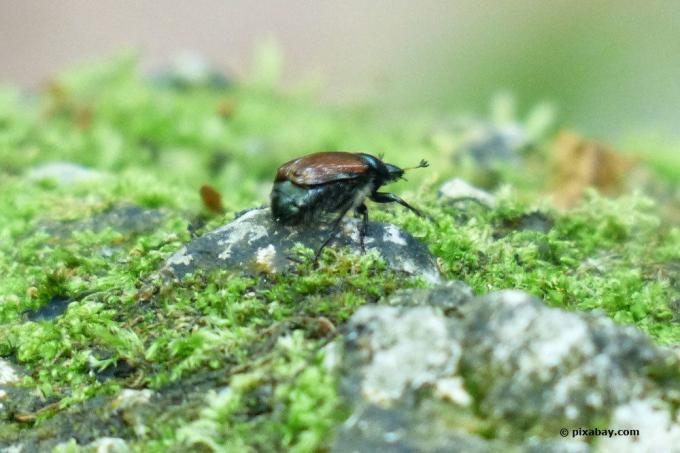
Cockchafer
- Size 2 to 3 cm
- Day active
- red-brown wings
- Underside, pronotum black
- both sides of the body have a black and white zigzag pattern
- 6 legs, 2 antennae
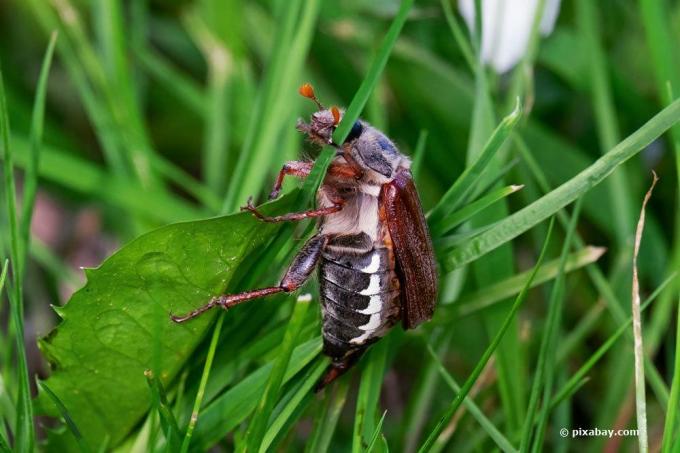
June beetle
- Flight time June / July
- Size 1 to 2 cm
- Active at twilight and at night
- light brown chitin armor
- slightly hairy head and neck area
- 6 legs, 2 antennae
Preventing grubs
If you want to avoid an infestation of the lawn with white grubs, you should already have the Egg laying contain or prevent the beetle from around May to July. This includes the following measures:
- Insect protection nets on smaller lawns
- Do not switch on lights such as spotlights in the evening
- Beetles like it light, avoid the dark and mostly fly during the day (except June beetles)
- dense, firm lawn cover
- White grubs don't like good watering either
- Dry, sandy and warm soil invites you to lay eggs
Fight grubs
It shouldn't be the chemical variant to combat grubs in the lawn. Because in addition to the preventive measures outlined above, there are several other ways to sensibly and with beetle larvae harmless agents to fight. In the following, we present measures that can be used to protect the lawn from dangerous damage from these pests. Sometimes they fall under the concept of Garden maintenance, others are home remedies based on traditional horticultural experience. However, it is important for all types of control to be carried out at the right time and consistently. Sometimes even plants and animals help us to get rid of the voracious maggots quickly.
Collecting instead of killing
Those who simply collect the larvae invest time, but have no costs and a very high success rate. Of course, this method can only be used on smaller lawns. When it has rained heavily, the grubs dig their way up, and collecting these larvae is a pure pleasure. Heavy rain can be replaced at any time by heavy watering of the lawn. This also drives the pests upwards, all that remains is collecting. The larvae also do not like loosening the soil by scarifying. But it is always good for the lawn.
Animals as useful helpers
A good and natural way to control white grubs in the lawn is theirs natural enemies to accommodate in the garden. The following measures are useful:
- Nesting places for blackbirds and other birds on trees
- Hedgehog-protected quarters, safe feeding places
Whenever there is still one or the other delicacy on offer, “grub-eaters” like to come and reduce the number of pests in the lawn. Because for the animals mentioned, larvae are a delicacy that is eaten with pleasure. In addition, hedgehogs and birds loosen up the soil, which is good for the lawn and annoys the larvae.
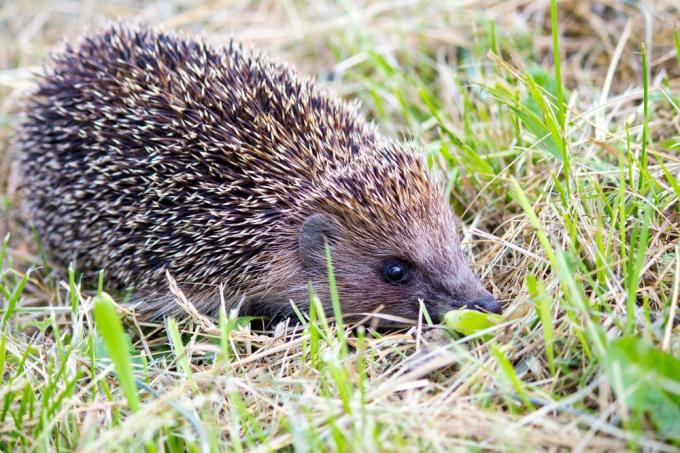
Fight with plants
If you place plants such as geraniums or delphiniums right next to a lawn or as its "fence", you can guarantee to reduce grubs. The following facts speak for it:
- Pretty, decorative plants
- Plants poisonous for beetle larvae
- Especially poisonous roots
- Roots are popular foods
- Garlic is a deterrent
In smaller lawn areas, garlic plants can often prevent the beetles from laying eggs, which garlic also avoid.
Falling
White grubs are easy to lure into traps. This can be arranged well with compost and horse manure, both substances are particularly fond of beetle larvae. And this is how it works, few accessories are required:
- Large buckets, planters or buckets of water
- Cow dung or compost
- Holes, approx. 50 cm deep
- Put containers in holes, cover with soil and mark
The horse manure magically attracts fresh larvae in particular, who have not yet experienced the enjoyment of grass roots. You get into the container and stay in it. So they can be excavated at any time and annually.
Housing offer
It is also a good trick to set up a kind of reserve with amenities for beetles and grubs, it has a number of advantages:
- Distract from the lawn
- Protection with deep lawn edges
- Range of popular dandelions
The pests are given a place in a corner that is well suited to distract from the nearby lawn. A small, overgrown area, for example planted with dandelions or with a little horse manure as an attractant, works wonders. Beetles and larvae cannot resist here, they can continue to live in a sheltered environment if hedgehogs and birds allow it.
Nematodes
Are nematodes invertebrate roundworms, a little less than 1 mm in size, but clearly visible with a magnifying glass. Specially suitable predatory Hm nematodes are available on the Internet or in specialist institutes. Mix the contents of the pack with the nematodes according to the instructions for use, distribute them on the lawn using pumps and suitable devices, e.g. a watering can. This method has the following advantages:
- Biological control, not chemistry
- Roundworms infect grubs
- Bacterium kills grubs (only takes 2-3 days)
Be sure to note:
- Application time between May and October
- Temperatures above 12 ° C
- Moist lawn

